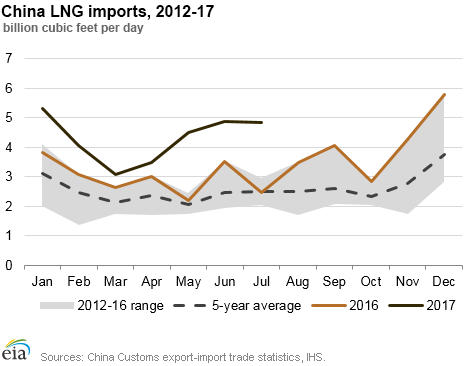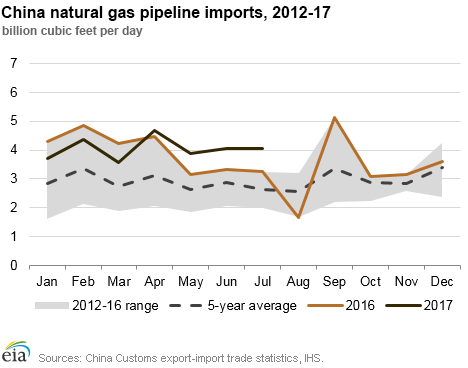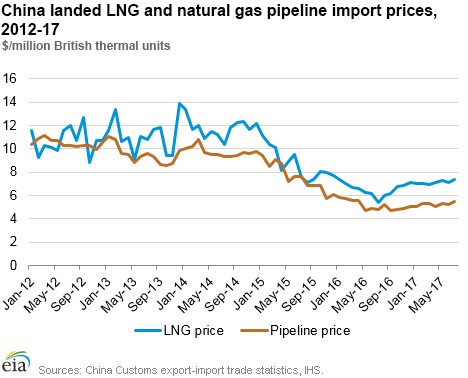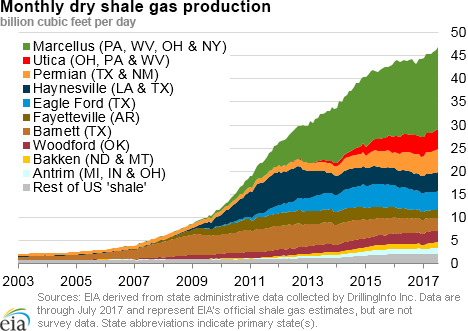In the News:
China's LNG imports set new record in 2017, further growth expected
Over the first seven months of 2017, China's imports of liquefied natural gas (LNG) averaged 4.3 billion cubic feet per day (Bcf/d), or 45% higher than during the same period in 2016. With the exception of a slight decline in 2015, LNG import into China have grown steadily over the last decade, increasing by 33% between 2015 and 2016. LNG imports growth has been supported by both government policies to replace some coal and oil use with natural gas as well as lower natural gas import prices.
In the first six months of 2017, Chinese natural gas consumption increased by 15% compared to 2016 levels, according to China’s National Development and Reform Commission (NDRC). This growth was driven primarily by coal-to-gas switching in the power generation and industrial sectors to meet environmental policy targets set in China's 2013 Air Pollution Prevention and Control Action Plan, increased demand by gas-fired power plants, and increased consumption in the transportation sector. Almost all of the targets set in this plan are supposed to be met by the end of 2017, and local governments are making efforts to comply by the deadline. Additionally, flooding in central and southern China this summer led to curtailment of hydroelectric power generation, requiring additional generation by gas-fired power plants.
While domestic production in China accounted for 64% of natural gas supply in 2016, production growth lagged behind increases in LNG and pipeline imports. Between 2015 and 2016, domestic production grew by 3% (0.3 Bcf/d), while LNG imports increased by 33% (0.9 Bcf/d) and pipeline imports by 13% (0.4 Bcf/d). Strong growth in LNG imports reflected their cost-competitiveness compared to pipeline imports, particularly in China’s coastal provinces, which account for the majority of natural gas consumption.
During the first seven months of 2017, average landed pipeline import prices in China averaged about $5.30 per million British thermal units ($/MMBtu), about $1.86 lower than landed LNG import prices. Most of China’s natural gas pipeline imports come from Turkmenistan, Uzbekistan, and Kazakhstan in Central Asia and enter the country in the west, requiring cross-country long-haul transportation to markets in the eastern provinces. Transport of this natural gas adds about $3.50-$4.00/MMBtu to the import price. LNG regasification facilities are located closer to major Chinese consuming centers in eastern provinces and LNG regasification costs add approximately $1.00/MMBtu to the landed LNG import price of $7.10/MMBtu.
Next year, EIA projects that China will overtake South Korea as the world's second largest LNG importer, as additional regasification terminals come online and LNG supply contracts ramp up. While most of China’s LNG imports are delivered under long-term contracts to specific terminals owned by major Chinese national oil companies, the volume of spot purchases is likely to increase in the future as other companies gain third-party access to regasification capacity and take advantage of the new opportunities from the growing global LNG spot market. Although the United States does not currently have long-term LNG export contracts to China, it has supplied 10 cargoes from the Sabine Pass LNG terminal between February 2016 and June 2017. Most of these cargoes were delivered as part of Shell’s global supply portfolio, which includes off-take volumes from Sabine Pass, and were a part of Shell’s long-term contract with China’s national oil company. The remainder of the cargoes were spot deals.
Overview:
(For the Week Ending Wednesday, September 6, 2017)
- Natural gas spot price movements were mixed this report week (Wednesday, August 30 to Wednesday, September 6). The Henry Hub spot price rose from $2.86 per million British thermal units (MMBtu) last Wednesday to $2.93/MMBtu yesterday.
- At the New York Mercantile Exchange (Nymex), the October 2017 contract price rose 6¢ from $2.939/MMBtu last Wednesday to $3.000/MMBtu yesterday.
- Net injections to working gas totaled 65 billion cubic feet (Bcf) for the week ending September 1. Working natural gas stocks are 3,220 Bcf, which is 6% less than the year-ago level and slightly higher than the five-year (2012–16) average for this week.
- The natural gas plant liquids composite price at Mont Belvieu, Texas, rose by 16¢, averaging $7.10/MMBtu for the week ending September 6. The price of ethane fell by 5%. The price of natural gasoline, propane, butane, and isobutane rose by 3%, 5%, 4%, and 3%, respectively.
Prices/Supply/Demand:
Price movements mixed this week. This report week (Wednesday, August 30 to Wednesday, September 6), the Henry Hub spot price rose 7¢ from $2.86/MMBtu last Wednesday to $2.93/MMBtu yesterday, but the week-over-week average Henry Hub price decreased 2¢, from $2.91/MMBtu to $2.89/MMBtu. Most of the Lower 48 states were cooler—by about 2° degrees Fahrenheit (°F), on average—over this report week compared to last report week, according to NOAA data. At the Chicago Citygate, prices increased 7¢ from $2.79/MMBtu last Wednesday to $2.86/MMBtu yesterday, but the week-over-week average Chicago spot price remained unchanged at $2.83/MMBtu.
The largest week-over-week average temperature increases were in Washington—from 67°F to 71°F—and Oregon—from 69°F to 72°F. Natural gas spot prices at the Northwest Sumas trading hub—a key trading hub for the Pacific Northwest—normally trade at a discount to the Henry Hub spot price. Last week, the average discount was 27¢, but this report week the average discount was 18¢.
The Wednesday-over-Wednesday price at PG&E Citygate in Northern California stayed level at $3.36/MMBtu, but the weekly average price increased 3¢. The price at SoCal Citygate decreased $1.35 from $4.60/MMBtu last Wednesday to $3.25/MMBtu yesterday, but the weekly average price increased 15¢. On September 1, the California Independent System Operator issued a Flex Alert for voluntary electricity conservation, while statewide-average temperatures in California on September 1 and 2 tied for the second and third warmest on record for these days and the warmest start to September on record.
Northeast prices mixed. At the Algonquin Citygate, which serves Boston-area consumers, prices went down 41¢ from $2.10/MMBtu last Wednesday to $1.69/MMBtu yesterday. Weekly average temperatures in Massachusetts decreased by 1°F, from 64°F to 63°F. However, prices rose with temperatures at the end of this report week—reaching an average of 71°F on Tuesday—but not enough to offset the week-over-week decreases. At the Transcontinental Pipeline Zone 6 trading point for New York, prices increased 54¢ from $1.88/MMBtu last Wednesday to $2.42/MMBtu yesterday. The weekly average price in New York increased by 16¢, and daily prices generally moved with temperatures.
Tennessee Zone 4 Marcellus spot prices decreased 26¢ from $1.60/MMBtu last Wednesday to $1.34/MMBtu yesterday. Prices at Dominion South in northwest Pennsylvania fell 19¢ from $1.60/MMBtu last Wednesday to $1.41/MMBtu yesterday.
Production increases, imports decrease. According to data from PointLogic Energy, the average total supply of natural gas rose by 2% compared with the previous week. Dry natural gas production grew by 2% compared with the previous report week. This increase in overall production occurred in spite of Hurricane Harvey reducing production in the Gulf of Mexico by an average of 409 million cubic feet per day (MMcf/d) between August 30 and September 4, according to the Bureau of Safety and Environmental Enforcement. Average net imports from Canada decreased by 1% from last week.
Overall demand remains flat. Total U.S. consumption of natural gas was unchanged from last week, averaging 55.7 Bcf/d according to data from PointLogic Energy. Natural gas consumed for power generation was flat, averaging 29.4 Bcf/d. Industrial sector consumption increased by 1% week over week. In the residential and commercial sectors, consumption declined by 5%. Natural gas exports to Mexico increased 6% from last week and are about 500 MMcf/d lower than pre-hurricane exports.
U.S. LNG exports resume. LNG vessel loadings resumed at Sabine Pass liquefaction terminal on Wednesday, September 6 with the arrival of LNG tanker Rioja Knutsen (LNG-carrying capacity 3.8 Bcf). The port of Sabine Pass was inaccessible to LNG vessels for almost two weeks, as port operations were suspended in the wake of Hurricane Harvey. The last loading at Sabine Pass liquefaction facility prior to the hurricane was on August 24. Currently, six vessels are around the Sabine Pass port waiting for a loading window, according to Bloomberg. The Sabine Pass terminal has two loading berths, allowing two LNG vessels to load at the same time.
Dominion Energy Cove Point LNG facility, which is currently under construction, received a letter of authorization from the Federal Energy Regulatory Commission to begin commissioning activities at the terminal, including introduction of feed gas to the pre-treatment and liquefaction areas. LNG exports from Cove Point are expected to begin by the end of this year, according to the terminal’s operator, Dominion Energy.
Storage:
Increased injection activity in the East region offsets net withdrawals west of the Rockies. Net injections into storage for the week ending September 1 totaled 65 Bcf, compared with the five-year (2012–16) average net injection of 58 Bcf and last year's net injections of 38 Bcf during the same week. Net injections into storage exceeded the five-year average by 14 Bcf in the East region and by 2 Bcf in the Midwest. In contrast, the Pacific region reported net withdrawals totaling 5 Bcf compared with the five-year average net injection of 1 Bcf, and the Mountain region reported no net change for the week, falling 3 Bcf below its five-year average. Working gas stocks total 3,220 Bcf, which is 15 Bcf more than the five-year average and 212 Bcf less than last year at this time.
The South Central region reports first net injection in eight weeks. This week marks the first week that net injections were reported for salt facilities in the South Central region since June 14. Working gas levels at salt facilities in the the South Central region increased by 4 Bcf. The South Central nonsalt region also reported a net injection of 3 Bcf. Net withdrawals from storage in the South Central salt region have totaled 29 Bcf so far during the 2017 refill season, compared with the five-year average net injections of 63 Bcf—a swing of 92 Bcf. Nevertheless, its working gas stocks remain 3% higher than the five-year average in the South Central region.
Storage surplus compared to five-year average falls to lowest level in 2017. The difference between working gas levels and the five-year average rose to 15 Bcf, after reaching its lowest level during the 2017 refill season the previous storage week. The storage surplus relative to the five-year average last peaked at 395 Bcf on March 10 and has posted declines in most weeks since then. Working gas stocks will end the refill season on October 31 slightly above the five-year average of 3,842 Bcf, if net injections match the five-year average for the remainder of the season. However, if net injections continue at their current rate, compared to the five-year average so far in the refill season, working gas stocks will end the refill season at 3,746 Bcf, or 96 Bcf lower than five-year average.
So far in the 2017 refill season, net injections into working gas storage are lower than the five-year average in most regions of the Lower 48 states. Net injections into working gas totaled 1,169 Bcf since March 31, 2017—the traditional beginning of the refill season—compared with the five-year average of 1,419 Bcf over the same period. Smaller-than-average net injections to date during the 2017 injection season are the result of high electric sector demand (that was coupled with warmer-than-normal temperatures on average), relatively high levels of natural gas exports, and storage levels that were already above average at the start of the refill season. The East region is the only region where net injections have exceeded the five-year average. Cumulative net injections during the 2016 refill season in the Lower 48 states totaled 954 Bcf by this time last year, which was also characterized by unusually high storage levels at the start of the 2016 refill season.
The January 2018 futures price continues trading at a premium over the current spot price. During the most recent storage week, the average natural gas spot price at the Henry Hub was $2.90/MMBtu, while the Nymex futures price of natural gas for delivery in January 2018 averaged $3.27/MMBtu, a difference of 38¢. The premium was 41¢ a year ago. The average natural gas spot price at the Henry Hub was 5¢ lower than the front-month futures price at the Nymex. A year ago, the spot price was 5¢ higher than the front-month contract.
Reported net implied flows into storage are close to analysts’ expectations. According to the Desk survey of natural gas analysts, estimates of net injections to working natural gas storage ranged from 58 Bcf to 83 Bcf with a median of 63 Bcf. Prices on the futures contract for October delivery rose 2¢/MMBtu to $3.01/MMBtu with 339 contracts traded at the release of the Weekly Natural Gas Storage Report (WNGSR). Prices varied close to $3.00/MMBtu in subsequent trading.
Temperatures cooler than normal in most of the Lower 48 states east of the Rockies during the week. Temperatures in the Lower 48 states averaged 71°F, 1°F lower than the normal and 5°F lower than last year at this time. Temperatures in northern areas of the Lower 48 states, including New England, Middle Atlantic, and the East and West North Central Census divisions ranged between 62°F and 68°F, or 2°F to 5°F below the normal. Temperatures in the southern areas, including the South Atlantic and the East and West South Central Census divisions ranged between 74°F and 77°F, or up to 4°F below the normal. Temperatures west of the Rocky Mountains averaged 77°F, about 6°F higher than the normal and 4°F higher than last year at this time.
See also:
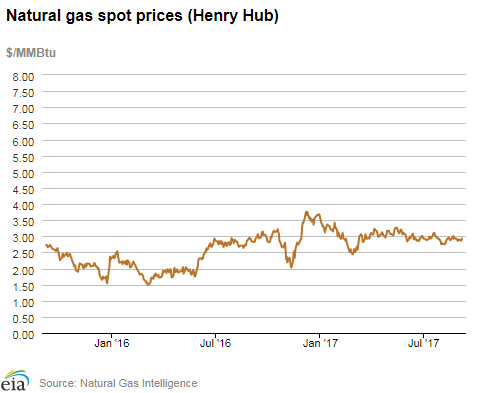
| Spot Prices ($/MMBtu) | Thu, 31-Aug |
Fri, 1-Sep |
Mon, 4-Sep |
Tue, 5-Sep |
Wed, 6-Sep |
|---|---|---|---|---|---|
| Henry Hub | 2.89 |
2.90 |
Holiday |
2.86 |
2.93 |
| New York | 2.31 |
1.65 |
Holiday |
2.50 |
2.42 |
| Chicago | 2.79 |
2.84 |
Holiday |
2.83 |
2.86 |
| Cal. Comp. Avg.* | 3.22 |
3.13 |
Holiday |
2.98 |
2.98 |
| Futures ($/MMBtu) | |||||
| October Contract | 3.040 |
3.070 |
Holiday |
2.972 |
3.000 |
| November Contract | 3.102 |
3.136 |
Holiday |
3.044 |
3.069 |
| *Avg. of NGI's reported prices for: Malin, PG&E Citygate, and Southern California Border Avg. | |||||
| Source: NGI's Daily Gas Price Index | |||||
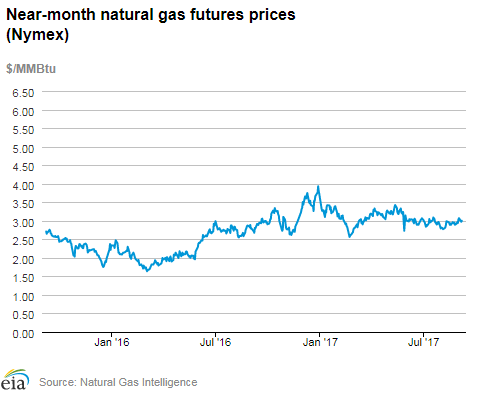
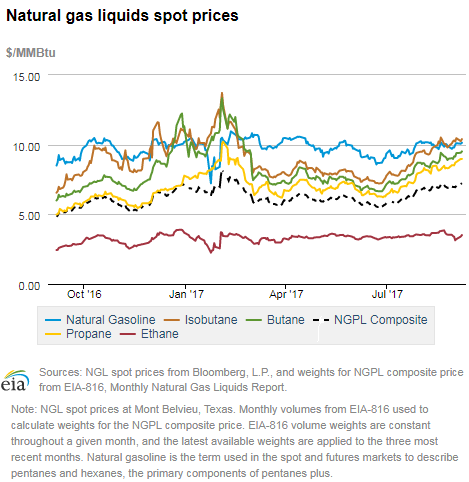
| U.S. natural gas supply - Gas Week: (8/31/17 - 9/6/17) | |||
|---|---|---|---|
Average daily values (Bcf/d): |
|||
this week |
last week |
last year |
|
| Marketed production | 82.7 |
80.7 |
80.1 |
| Dry production | 73.4 |
71.7 |
71.3 |
| Net Canada imports | 5.5 |
5.5 |
5.2 |
| LNG pipeline deliveries | 0.1 |
0.0 |
0.1 |
| Total supply | 79.0 |
77.2 |
76.6 |
|
Source: OPIS PointLogic Energy, an IHS Company | |||
| U.S. natural gas consumption - Gas Week: (8/31/17 - 9/6/17) | |||
|---|---|---|---|
Average daily values (Bcf/d): |
|||
this week |
last week |
last year |
|
| U.S. consumption | 55.7 |
55.8 |
57.3 |
| Power | 29.4 |
29.4 |
31.0 |
| Industrial | 20.0 |
19.7 |
19.4 |
| Residential/commercial | 6.4 |
6.7 |
6.9 |
| Mexico exports | 4.1 |
3.9 |
4.2 |
| Pipeline fuel use/losses | 6.2 |
6.0 |
6.3 |
| LNG pipeline receipts | 0.5 |
1.8 |
1.1 |
| Total demand | 66.5 |
67.5 |
68.8 |
|
Source: OPIS PointLogic Energy, an IHS Company | |||
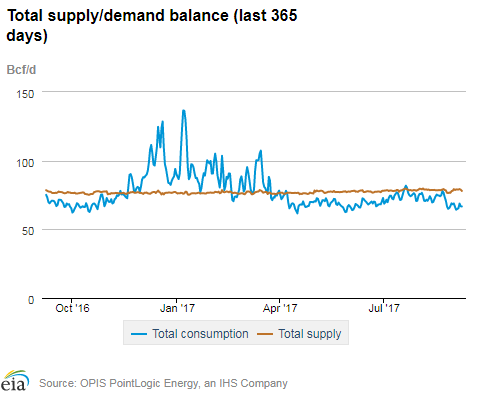
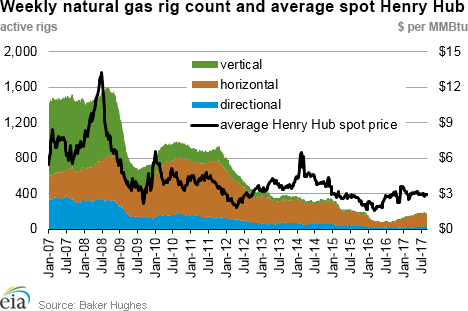
| Rigs | |||
|---|---|---|---|
Fri, September 01, 2017 |
Change from |
||
last week |
last year |
||
| Oil rigs | 759 |
0.0% |
86.5% |
| Natural gas rigs | 183 |
1.7% |
108.0% |
| Note: Excludes any miscellaneous rigs | |||
| Rig numbers by type | |||
|---|---|---|---|
Fri, September 01, 2017 |
Change from |
||
last week |
last year |
||
| Vertical | 68 |
6.3% |
13.3% |
| Horizontal | 794 |
-0.3% |
101.0% |
| Directional | 81 |
1.3% |
92.9% |
| Source: Baker Hughes Inc. | |||
| Working gas in underground storage | ||||
|---|---|---|---|---|
Stocks billion cubic feet (Bcf) |
||||
| Region | 2017-09-01 |
2017-08-25 |
change |
|
| East | 781 |
749 |
32 |
|
| Midwest | 872 |
840 |
32 |
|
| Mountain | 205 |
205 |
0 |
|
| Pacific | 296 |
301 |
-5 |
|
| South Central | 1,066 |
1,060 |
6 |
|
| Total | 3,220 |
3,155 |
65 |
|
| Source: U.S. Energy Information Administration | ||||
| Working gas in underground storage | |||||
|---|---|---|---|---|---|
Historical comparisons |
|||||
Year ago (9/1/16) |
5-year average (2012-2016) |
||||
| Region | Stocks (Bcf) |
% change |
Stocks (Bcf) |
% change |
|
| East | 810 |
-3.6 |
775 |
0.8 |
|
| Midwest | 925 |
-5.7 |
865 |
0.8 |
|
| Mountain | 224 |
-8.5 |
191 |
7.3 |
|
| Pacific | 313 |
-5.4 |
333 |
-11.1 |
|
| South Central | 1,161 |
-8.2 |
1,040 |
2.5 |
|
| Total | 3,432 |
-6.2 |
3,205 |
0.5 |
|
| Source: U.S. Energy Information Administration | |||||
| Temperature – heating & cooling degree days (week ending Aug 31) | ||||||||
|---|---|---|---|---|---|---|---|---|
HDD deviation from: |
CDD deviation from: |
|||||||
| Region | HDD Current |
normal |
last year |
CDD Current |
normal |
last year |
||
| New England | 21 |
13 |
21 |
2 |
-19 |
-63 |
||
| Middle Atlantic | 9 |
5 |
9 |
5 |
-28 |
-68 |
||
| E N Central | 17 |
9 |
17 |
11 |
-21 |
-57 |
||
| W N Central | 9 |
-3 |
4 |
32 |
-12 |
-25 |
||
| South Atlantic | 1 |
0 |
1 |
71 |
-10 |
-39 |
||
| E S Central | 1 |
0 |
1 |
61 |
-13 |
-52 |
||
| W S Central | 0 |
0 |
0 |
84 |
-26 |
-30 |
||
| Mountain | 0 |
-15 |
-9 |
85 |
25 |
22 |
||
| Pacific | 0 |
-6 |
0 |
86 |
46 |
32 |
||
| United States | 7 |
1 |
6 |
50 |
-5 |
-31 |
||
|
Note: HDD = heating degree day; CDD = cooling degree day Source: National Oceanic and Atmospheric Administration | ||||||||
Average temperature (°F)
7-Day Mean ending Aug 31, 2017
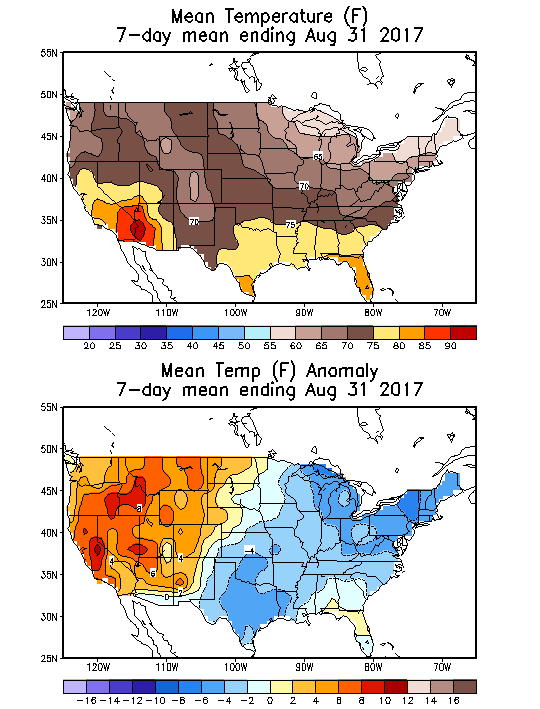
Source: NOAA National Weather Service
Deviation between average and normal (°F)
7-Day Mean ending Aug 31, 2017

Source: NOAA National Weather Service

